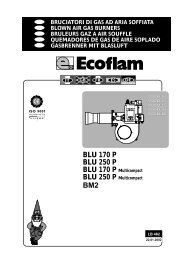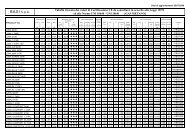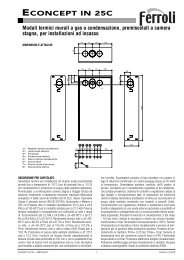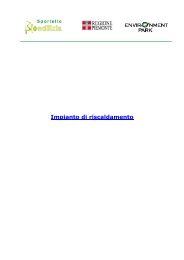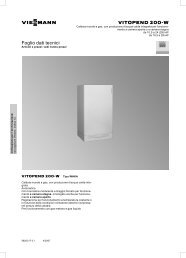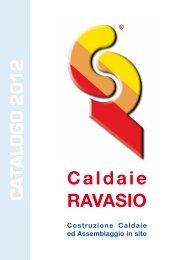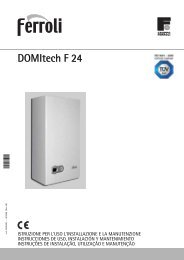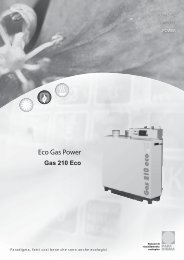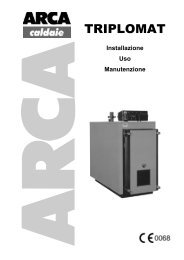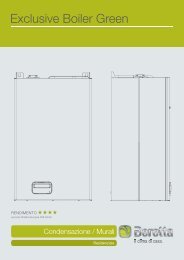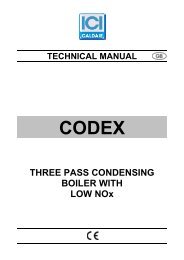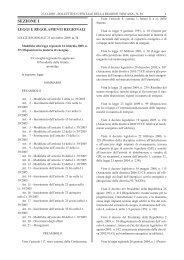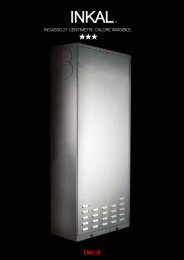aermec idrosplit - Certificazione energetica edifici
aermec idrosplit - Certificazione energetica edifici
aermec idrosplit - Certificazione energetica edifici
Create successful ePaper yourself
Turn your PDF publications into a flip-book with our unique Google optimized e-Paper software.
INSTALLAZIONE • INSTALLATION<br />
MODULO ID • ID MODULE<br />
Il modulo ID va installato verticalmente a parete, agganciandolo<br />
alla dima metallica disponibile come accessorio.<br />
Tale dima deve essere utilizzata come riferimento per la<br />
posizione degli attacchi idraulici e frigoriferi (Fig. 5 e 6).<br />
Per il fissaggio a parete della dima si utilizzino tasselli ad<br />
espansione (o altro tipo di ancoraggio adatto alla struttura<br />
della parete) di adeguata portata.<br />
Per l’accessibilità ai componenti interni e alla scatola elettrica,<br />
è necessario asportare il mantello.<br />
A tal proposito, bisogna (Fig. 7):<br />
– togliere le due viti (1) nella parte inferiore;<br />
– smontare, con cautela, la maschera frontale in plastica (2)<br />
fissata ad incastro, eventualmente facendo leva con un<br />
utensile;<br />
– sganciare il mantello (3), sollevandolo di qualche centimetro.<br />
Per l’accessibilità ai componenti idraulici, situati nella parte<br />
superiore, è necessario asportare il guscio in polistirolo (4).<br />
Per tale operazione, si raccomanda la massima attenzione<br />
per evitare possibili danneggiamenti, in quanto tale guscio<br />
deve assicurare la tenuta ermetica con l’ambiente esterno,<br />
in modo da evitare la formazione di condensa sulle parti<br />
fredde.<br />
COLLEGAMENTI IDRAULICI • WATER CONNECTIONS<br />
Il modulo Idrosplit deve essere collegato alla caldaia autonoma<br />
od all’impianto di riscaldamento centralizzato. La distribuzione<br />
dell’acqua calda e fredda avviene dal modulo ID.<br />
Gli attacchi idraulici (fig. 6) sono situati nella parte inferiore<br />
e sono protetti da tappi di plastica; i collegamenti da eseguire<br />
sono (vedi “Schema di funzionamento”):<br />
- collegamento tra il modulo ID e l’eventuale caldaia o<br />
impianto di riscaldamento centralizzato, da effettuarsi tramite<br />
una tubazione di mandata ed una di ritorno. Nel<br />
caso non sia installata la caldaia, le due tubazioni di collegamento<br />
corrispondenti dovranno essere intercettate.<br />
- collegamento tra il modulo ID e le unità terminali del tipo<br />
a ventilconvettore. Questi ultimi devono essere collegati<br />
in parallelo, per garantire nel funzionamento estivo la<br />
minima temperatura dell’acqua in ingresso.<br />
Si raccomanda di eseguire un accurato bilanciamento del<br />
circuito, in modo da assicurare la portata di progetto alle<br />
unità terminali.<br />
Tutti i ventilconvettori dovranno essere provvisti di tubazioni<br />
per il drenaggio della condensa.<br />
Nel caso di installazione di caldaia con produzione instantanea<br />
di acqua sanitaria, se nel funzionamento invernale, in<br />
caso di richiesta, l’intera potenza termica della caldaia<br />
viene destinata alla produzione di acqua sanitaria, si consiglia<br />
di dotare i ventilconvettori di sonda di minima temperatura<br />
in modo da fermare la ventilazione quando l’acqua<br />
nelle batterie di scambio scende al di sotto di una certa<br />
temperatura. Si evitano così correnti di aria fredda in caso<br />
di richieste prolungate di acqua sanitaria.<br />
Nel caso in cui si volessero inserire alcuni radiatori per il<br />
riscaldamento, essi dovranno essere idraulicamente intercettabili<br />
ed esclusi durante il funzionamento estivo dell’impianto:<br />
tale condizione si realizza inserendo i radiatori come<br />
indicato nel capitolo “Schema di funzionamento”, eventualmente<br />
intercettandoli con una valvola di zona, che interrompa<br />
l’afflusso di acqua all’accensione di Idrosplit.<br />
The ID module must be installed vertically to a wall,<br />
hooking it onto the metal template available as an accessory.<br />
This template must be used as reference for the<br />
hydraulic and refrigerant connections (Fig. 5 and 6).<br />
The template is fixed to the wall by expansion bolts (or<br />
other type of fixing suitable to the wall structure) with adequate<br />
load bearing.<br />
To access the internal components and the switchbox, the<br />
cover must be removed.<br />
For this purpose (Fig. 7):<br />
- remove the two screws (1) in the lower section;<br />
- remove, with extreme care, the plastic clip-on fascia (2),<br />
eventually using a tool as a lever;<br />
- unhook the cover (3), lifting it by a few centimetres.<br />
To access the hydraulic components, found in the top section,<br />
the polystyrene packing (4) must be removed.<br />
In this operation take extreme care to avoid damaging the<br />
padding, since it must ensure a hermetic seal with the outside,<br />
to prevent the formation of condensate on the cold<br />
parts.<br />
The Idrosplit module must be connected to the boiler or<br />
central heating plant. The distribution of hot or cold water is<br />
made through the ID module.<br />
The hydraulic couplings (fig. 6) are found in the lower section<br />
and are protected by plastic caps. The connections to<br />
make are (see “Operating diagram”):<br />
- connect the ID module to the eventual boiler, or central<br />
heating plant, with delivery and return piping. If the boiler<br />
is not installed, the two connecting pipes must be shut-off.<br />
- connect the ID module to the fancoil terminal units. The<br />
fancoils must be connected in parallel to guarantee in<br />
summer operation the minimum inlet water temperature.<br />
It is essential that the circuit is balanced perfectly, to ensure<br />
the design flow to the terminal units.<br />
All the fancoils must be provided with condensate drain<br />
piping.<br />
If a boiler is installed, with instant production of sanitary<br />
water, and in case of a requirement during winter operation,<br />
while the whole thermal capacity of the boiler is designated<br />
to the production of sanitary water, it is advisable to fit the<br />
fancoils with a minimum temperature sensor so that ventilation<br />
is stopped when the water in the exchange coils drops<br />
below a given temperature. This avoids cold air currents in<br />
case of extended requirements of sanitary water.<br />
In the case where some radiators are required for heating,<br />
they must be installed so that that they may be isolated<br />
during summer operation of the plant. This condition is<br />
achieved by fitting the radiators according to chapter<br />
“Operating diagram”, eventually shutting them off with a<br />
local valve, which cuts off their water supply when the<br />
Idrosplit is turned on.<br />
COLLEGAMENTI FRIGORIFERI • REFRIGERANT CONNECTIONS<br />
Per il collegamento frigorifero delle unità interna ed esterna<br />
sono disponibili come accessorio le linee LG, con tubi in<br />
rame isolati e chiusi alle estremità per evitare ingresso di<br />
impurità.<br />
I tubi sono già svasati e muniti di dadi conici.<br />
Qualora non si desideri utilizzare tale accessorio per la pre-<br />
For the refrigerant connections of the indoor and outdoor<br />
units the LG lines are available as accessory, with insulated<br />
copper pipe closed at both ends as a protection against<br />
impurities.<br />
The pipes are already flared and fitted with conical nuts.<br />
If this accessory is not used, prepare the lines as follows (for<br />
34



